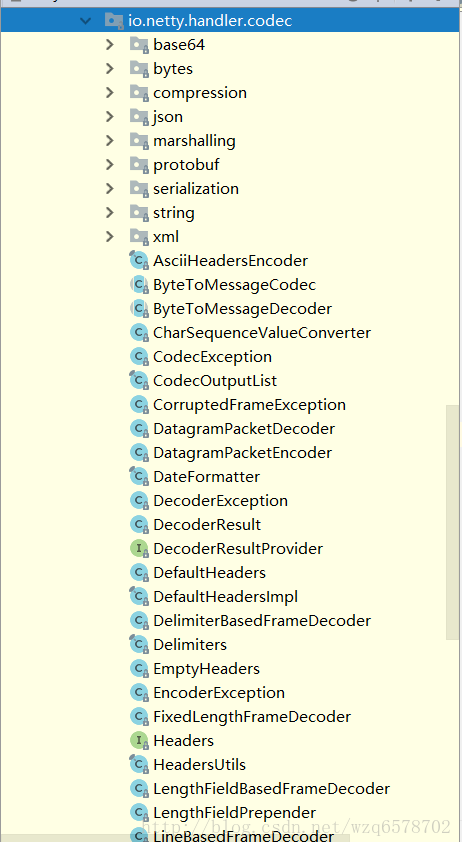Netty处理器重要概念:
1、Netty的处理器可以分为两类:入栈处理器和出栈处理器。
2、入栈处理器的顶层是ChannelInboundHandler,出栈处理器的顶层是ChannelOutboundHandler。
3、数据处理时常用的各种编解码器本质上都是处理器。
4、编解码器:无论我们是向网络中写入数据是什么类型(int、char、String、二进制等),数据在网络中传递时,其都是以字节流的形式出现的;将数据由原本的形式转换为字节流的操作称为编码(encode),将数据由字节转换为它原本的格式或是其他格式的操作称为解码(decode),编码统一称为codec。
5、编码:本质上是一种出栈处理器;因此,编码一定是一种ChannelOutboundHandler。
6、解码:本质上是一种入栈处理器,因此。解码一定是一种ChannelInboundHandler。
7、在Netty中,编码器通常以XXXEncoder命名;解码器通常以XXXDecoder命名。
netty下边有很多编解码器的实现:

实际开发的过程中我们可以去使用它们,我们要讲的不是去使用它们,现在以一个例子来说明编解码的一些内幕:
netty提供了一个字节到消息的转换器(ByteToMessageDecoder):

接下来我们使用ByteToMessageDecoder自己实现一个解码器:
1
2
3
4
5
6
7
8
9
10
11
12
|
public class MyByteToLongDecoder extends ByteToMessageDecoder {
@Override
protected void decode(ChannelHandlerContext ctx, ByteBuf in, List<Object> out) throws Exception {
System.out.println("decode invoked");
System.out.println(in.readableBytes());
if(in.readableBytes()>=8){
out.add(in.readLong());
}
}
}
|
然后需要一个将Long类型的数据转换为byte的书装换器:
使用MessageToByteEncoder:
服务端:
1
2
3
4
5
6
7
8
9
10
11
12
13
14
15
16
17
18
19
20
21
| /**
* Created by Administrator on 2017/5/20.
* 服务器和客户端互发程序
*/
public class MyServer {
public static void main(String[] args) throws InterruptedException {
EventLoopGroup bossGroup = new NioEventLoopGroup(1);
EventLoopGroup workerGroup = new NioEventLoopGroup();
try{
ServerBootstrap serverBootstrap = new ServerBootstrap();
serverBootstrap.group(bossGroup,workerGroup).channel(NioServerSocketChannel.class)
.childHandler(new MyServerInitializer());
ChannelFuture channelFuture = serverBootstrap.bind(8899).sync();
channelFuture.channel().closeFuture().sync();
}finally{
bossGroup.shutdownGracefully();
workerGroup.shutdownGracefully();
}
}
}
|
服务端初始化:
1
2
3
4
5
6
7
8
9
| public class MyServerInitializer extends ChannelInitializer<SocketChannel> {
@Override
protected void initChannel(SocketChannel ch) throws Exception {
ChannelPipeline pipline = ch.pipeline();
pipline.addLast(new MyByteToLongDecoder());
pipline.addLast(new MyLongToByteEncoder());
pipline.addLast(new MyServerHandler());
}
}
|
服务端handler:
1
2
3
4
5
6
7
8
9
10
11
12
| public class MyServerHandler extends SimpleChannelInboundHandler<Long> {
@Override
protected void channelRead0(ChannelHandlerContext ctx, Long msg) throws Exception {
System.out.println(ctx.channel().remoteAddress()+" --> "+msg);
}
@Override
public void exceptionCaught(ChannelHandlerContext ctx, Throwable cause) throws Exception {
cause.printStackTrace();
ctx.close();
}
}
|
客户端:
1
2
3
4
5
6
7
8
9
10
11
12
13
14
15
| public class Myclient {
public static void main(String[] args) throws InterruptedException {
EventLoopGroup eventLoopGroup = new NioEventLoopGroup();
try {
Bootstrap bootstrap = new Bootstrap();
bootstrap.group(eventLoopGroup).channel(NioSocketChannel.class).handler(new MyClientIniatializer());
ChannelFuture channelFuture = bootstrap.connect("localhost", 8899).sync();
channelFuture.channel().writeAndFlush("hello");
channelFuture.channel().closeFuture().sync();
} finally {
eventLoopGroup.shutdownGracefully();
}
}
}
|
客户端的initializer:
1
2
3
4
5
6
7
8
9
10
11
12
| public class MyClientIniatializer extends ChannelInitializer<SocketChannel> {
@Override
protected void initChannel(SocketChannel ch) throws Exception {
ChannelPipeline pipline = ch.pipeline();
pipline.addLast(new MyByteToLongDecoder());
pipline.addLast(new MyLongToByteEncoder());
pipline.addLast(new MyClientHandler());
}
}
|
客户端handler:
1
2
3
4
5
6
7
8
9
10
11
12
13
14
15
16
17
18
| public class MyClientHandler extends SimpleChannelInboundHandler<Long> {
@Override
protected void channelRead0(ChannelHandlerContext ctx, Long msg) throws Exception {
System.out.println(ctx.channel().remoteAddress());
System.out.println("client output "+msg);
}
@Override
public void channelActive(ChannelHandlerContext ctx) throws Exception {
ctx.writeAndFlush(123456L);//一定要加L,否则会作为int类型处理,最终导致消息发送不出去。
}
@Override
public void exceptionCaught(ChannelHandlerContext ctx, Throwable cause) throws Exception {
super.exceptionCaught(ctx, cause);
ctx.close();
}
}
|
字节到Long类型的解码器(解析网络传过来的数据):
1
2
3
4
5
6
7
8
9
10
| public class MyByteToLongDecoder extends ByteToMessageDecoder {
@Override
protected void decode(ChannelHandlerContext ctx, ByteBuf in, List<Object> out) throws Exception {
System.out.println("decode invoked");
System.out.println(in.readableBytes());
if(in.readableBytes()>=8){
out.add(in.readLong());
}
}
}
|
Long类型转换为字节(发送到网络之前的转换):
1
2
3
4
5
6
7
8
| public class MyLongToByteEncoder extends MessageToByteEncoder<Long> {
@Override
protected void encode(ChannelHandlerContext ctx, Long msg, ByteBuf out) throws Exception {
System.out.println("encode invoked");
System.out.println(msg);
out.writeLong(msg);
}
}
|
运行服务端,之后运行客户端,打印输出:
server端输出:
1
2
3
4
| decode invoked
8
/127.0.0.1:4679 --> 123456
|
client输出:
至于为什么是这样一个过程:
首先客户端启动之后,调用MyLongToByteEncoder的encode方法打印“encode invoked”和发送的数据“123456”。
服务段接受到之后调用MyByteToLongDecoder的decode打印“decode invoked”和数据长度“8”,之后是调用MyClientHandler的channelRead0打印“/127.0.0.1:4679 –> 123456”
接下来我们修改MyClientHandler如下:
1
2
3
4
5
6
7
8
9
10
11
12
13
14
15
16
17
18
19
20
21
22
23
24
25
26
| public class MyClientHandler extends SimpleChannelInboundHandler<Long> {
@Override
protected void channelRead0(ChannelHandlerContext ctx, Long msg) throws Exception {
System.out.println(ctx.channel().remoteAddress());
System.out.println("client output "+msg);
}
@Override
public void channelActive(ChannelHandlerContext ctx) throws Exception {
// ctx.writeAndFlush(123456L);
/*
都可以发送
ctx.writeAndFlush(1L);
ctx.writeAndFlush(2L);
ctx.writeAndFlush(3L);
ctx.writeAndFlush(4L);*/
ctx.writeAndFlush(Unpooled.copiedBuffer("helloworld", Charset.forName("utf-8")));
}
@Override
public void exceptionCaught(ChannelHandlerContext ctx, Throwable cause) throws Exception {
super.exceptionCaught(ctx, cause);
ctx.close();
}
}
|
ctx.writeAndFlush(Unpooled.copiedBuffer(“helloworld”, Charset.forName(“utf-8”)));
这行代码,即发送一个Buffer,我们查看控制台打印的数据:
server端的打印:
1
2
3
4
5
| decode invoked
10
/127.0.0.1:6394 --> 7522537965574647666
decode invoked
2
|
客户端没有任何输出,因为我们的客户端使用的是ByteBuff,而客户端的编码器是Long类型的,所以编码器没有执行,直接把数据丢给了Socket传输到了网络,所以服务端会收到数据,我们发送的数据是“helloworld”由于是utf-8,所以一个英文字符是一个字节,一共是10个字节,我们解码器只有在大于8个字节的时候才会对其进行解码然后给到下一个处理器,所以10个字节前8个通过了解码器,去了下一个handler,而剩下的2个没有通过解码器,服务端打印的“/127.0.0.1:6394 –> 7522537965574647666”后边的那串数字是8个字节的数据。
关于netty编解码器的重要结论:
1、无论是编码器还是解码器,其接受的消息类型必须要与待处理的参数类型一致,否则该编码器或解码器并不会执行。
2、在解码器进行数据解码时,一定要记得判断缓冲(ByteBuf)中的数据是否 足够,否则将会产生一些问题。
例如上边的例子判断是否是8个长度(因为long是占用8个字节的数据类型):
1
2
3
4
5
6
7
| protected void decode(ChannelHandlerContext ctx, ByteBuf in, List<Object> out) throws Exception {
System.out.println("decode invoked");
System.out.println(in.readableBytes());
if(in.readableBytes()>=8){
out.add(in.readLong());
}
}
|

